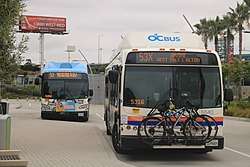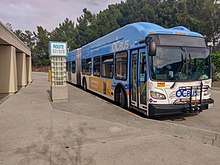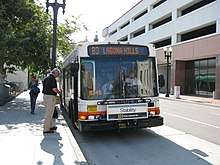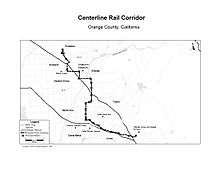Orange County Transportation Authority
The Orange County Transportation Authority (OCTA) is the public sector transportation planning body and mass transit service provider for Orange County, California in the Los Angeles metropolitan area. The agency is the second-largest public transportation provider in the metropolitan area after Los Angeles County Metropolitan Transportation Authority Its ancestor agencies include not only the prior Orange County Transit District but also such diverse entities as the Pacific Electric Railway and the South Coast Transit Corporation. In 2005, OCTA was judged America's Best Public Transportation System by the American Public Transportation Association, for its record gains in bus and Metrolink commuter trains ridership that it operates or funds. OCTA also operates the 91 Express Lanes.
 | |
 OCTA units 5540 and 5745 parked at ARTIC in Anaheim | |
| Founded | 1991 |
|---|---|
| Headquarters | 550 S. Main St. Orange, California, USA |
| Service area | Orange County |
| Service type | bus service, paratransit, toll roads, light rail (operating in 2022)[1] |
| Routes | 60[2] |
| Stops | 5,400 |
| Destinations | Orange and Los Angeles Counties |
| Fleet | 510 buses |
| Annual ridership | 51.4 million passengers per year (FY 2012-13) |
| Fuel type | CNG, Hydrogen |
| Operator | OCTA First Transit MV Transportation |
| Chief executive | Darrell Johnson |
| Website | octa.net |
The Authority's administrative offices are located in the city of Orange and it maintains bus operations bases in the cities of Garden Grove, and Santa Ana. First Transit operates about 40% of OCTA's Fixed Routes out of the Anaheim and Irvine bases, while MV Transportation operates OCTA's paratransit base for the authority's ACCESS service, also in Irvine.
History

OCTA's predecessor agency, the Orange County Transit District, was created in August 1972 by a referendum of county voters. It originally started as Santa Ana Transit, a small transit agency with five bus routes operating in Orange County. Santa Ana Transit later merged with other, smaller agencies throughout the county, eventually leading to the formation of OCTD. The routing system was formed over the course of about 15 years and was held in place until the merge to OCTA.
In 1991, OCTA was created under state law, combining the seven separate Orange County agencies that managed transportation planning:
- Orange County Transportation Commission
- Orange County Transit District
- Consolidated Transportation Services Agency
- Orange County Local Transportation Authority
- Orange County Service Authority for Freeway Emergencies
- Orange County Congestion Management Agency
- Orange County Service Authority for Abandoned Vehicles
Park-and-ride facilities, public transportation and other transportation related administrative offices merged into one organization. OCTA administers funds from Measure M (also known as OC Go), the half-cent transportation sales tax. Measure M was originally passed in 1990 and renewed in 2006. It has paid for the expansion on most freeways within Orange County, street improvements and repairs, traffic signal synchronization, and increased Metrolink service.[3]
In 1995, OCTA suffered tremendously during the Orange County bankruptcy and never fully recovered. The agency lost $202 million in revenue over 17 years due to the bankruptcy.[4] As a result, bus service was reduced.
In October 2015, OCTA rebranded its bus services as "OC Bus" and launched the OC Bus 360° plan, which aims to consolidate routes into more frequent service and increase ridership. OCTA also plans to replace 40% of its bus fleet with compressed natural gas-powered vehicles.[5][6][7] The change was approved by the OCTA board on February 22, 2016.[8]
Bus service
NOTE: Saturday schedule began on June 14th, 2020 due to the COVID-19 outbreak up to further notice.

Routes
OCTA operates 58 bus lines under the OC Bus brand, encompassing every city in Orange County. Some of the lines serve the Los Angeles County border communities of Lakewood, La Mirada, Cerritos, Hawaiian Gardens and Long Beach along with express service to Los Angeles, and the Riverside County city of Riverside via the La Sierra Metrolink Station.

- 1-99 are the fixed routes that cover almost every city in Orange County. Buses operate on most major arterial streets. Route 1 is a "special case" in that it is the only single-digit route, acquiring the number from the Pacific Coast Highway (California State Route 1) and internally to the transit authority (as it was when it was operated by OCTD) the route number is 95. Routes 53, 57, and 64 also feature Xpress bus service with limited stop service between 6am and 6pm on weekdays. These buses are differentiated by adding an X to the end of each respective route.
- 100-199 routes descended from the old RunAbout service that formerly served residential neighborhoods, or provide service to portions of 1-99 routes which have reduced demand. Three routes (129, 143, 153) are routes that were truncated from routes 29, 43, 47, 53 and 59 as a result of the March 2010 service changes.
- 200-299 routes are intra-county express routes branded "OC Express" which travel solely within Orange County and utilize the county's freeways. These routes run from park-and-rides and transit terminals to the business districts and back. These routes operate only during weekday rush hours.
- 400-499 routes are StationLink routes, Metrolink shuttles which travel from the Metrolink stations to business districts and vice versa. These routes operate only during weekday rush hours and do not operate reverse peak services.
- 500-599 Bravo! Express. These are routes that operate on heavily used routes. They make limited stops and only stop at transfer points to other routes. Currently routes 529, 543 and 560 are in use, 529 operates from the Fullerton Park and Ride to the Goldenwest Transportation Center in Huntington Beach, 543 operates on Harbor Blvd. from the Fullerton Transportation Center to MacArthur and Harbor in Santa Ana, and route 560 operates between the Santa Ana Regional Transportation Center and California State University, Long Beach. It is named according to the parent route it accompanies, by just adding a 5 to the beginning of the route indicating express. Bravo! routes use a dedicated fleet of buses and have different color schemes from regular route buses.
- 600-699 are special use routes, primarily used to transport passengers between the OC Fair and different locations around Orange County and vice versa to the fairgrounds located in Costa Mesa. Other uses include The Solar Decathlon in Irvine and the Summer Breeze service in Laguna Beach
- 700-799 routes are intercounty express bus services. Lines 701 and 721 go from the cities of Huntington Beach and Fullerton, respectively, to Downtown Los Angeles using the Harbor Freeway Transitway, while Line 794 connects the city of Costa Mesa to Riverside. All three inter-county express routes charge an additional fare in addition to the base fare. These routes operate only during weekday rush hours and route 721 is the only inter-county express route that operates reverse peak services between Fullerton and Downtown Los Angeles.
- 800-899 are City Shuttle routes. Route 862, the first and only 800 series route, serves as a circulator route in Downtown Santa Ana and was introduced in October 2019.
Some routes operate short turn trips which either start or end in the middle of the route.
All OCTA buses are equipped with bike racks and can carry between two and three bicycles at any given time. Bikes are only permitted on board buses if both racks on any particular bus are taken and that same bus happens to be the last trip of the day.
South Coast Plaza is the most served attraction on the OCTA routes, served by 6 routes (55, 57, 86, 150, 463, 794). The longest is route 1 , (Long Beach–San Clemente) which utilizes Pacific Coast Highway for the vast majority of its route of over 40 miles. Trips take an average of 2 to 2.5 hours.
Routes 43, 50, 57, and 60 were four routes that formerly operated 24 hours a day. "Night Owl" service, from 1 a.m to 4 a.m., was dropped on March 14, 2010 due to budget cutbacks. OCTA also eliminated routes 62, 74, 75, 131, 147, and 164 and reduced frequency of trips in March 2010 to save money.[9]
Fares[10]
NOTE: all fares are free since early April 2020 due to the ongoing COVID-19 outbreak up to further notice; riders board & exit via rear doors.
Under 6 pay no fare if accompanied with fare-paying rider; up to 3.
| Type | Regular | Seniors (60+)
Persons w/ Disabilities w/ ID |
ACCESS Eligible
Fixed-Route Local Fare |
|---|---|---|---|
| Local Single Ride | $2 | $0.75 | $0.25 |
| Express Routes
(701, 721 and 794) |
$7
($5 w/ any other valid pass) |
$6
($5.25 w/ any other valid pass) |
n/a |
| OC Express Routes
(206 and 213) |
$4
($2 w/ any other valid pass) |
$3.50
($2.75 w/ any other valid pass) |
n/a |
| Pass Type | Regular | Seniors (60+)
Persons w/ Disabilities w/ ID |
Youth (6-18) |
|---|---|---|---|
| 24-Hour Pass
(Sold on board by operator) |
$5 ($4.50 if purchased on OC Bus mobile app) | $1.50 | $5 ($4.50 if purchased on OC Bus mobile app) |
| Pre-Paid 24-Hour Pass | $4.50 | $1.35 | $4.50 |
| 30-Day Pass | $69 | $22.25 | $40 |
| Pass Type | 24-Hour
(Sold on board by operator) |
Senior and Disabled
24-Hour |
30-Day | Senior and Disabled
30-Day |
|---|---|---|---|---|
| Express Routes
(701, 721, and 794) |
$14 | $12 | $210 | $180 |
| OC Express Routes
(206 and 213) |
$8 | $7 | $120 | $105 |
Passes can be purchased from the OCTA website, in person at various retailers, or using the OCTA Mobile Ticketing App.
OCTA also offers various specialty passes such as passes for local university students, discounted 30-Day passes during the summer season, and others. In addition, students from Santa Ana College, Santiago Canyon College, Fullerton College, and Golden West College can local fixed route buses for free using their student ID.
Free transfers are available from various area agencies.
Roster
Current
OCTA's cutaways are excluded from this list.
| Make/ Model |
Year | Numbers (Quantity Ordered) |
Engine/ Transmission |
Fuel Propulsion | Assigned Divisions | Notes |
|---|---|---|---|---|---|---|
| NFI C40LFR |
2007-2009 | 5501-5599, 5601-5678 (177 buses) |
5501-5599, 5601-5674: Cummins ISL-G
5675-5678: Cummins ISL G NZ
|
CNG | Anaheim, Irvine, Santa Ana |
|
| NFI C40LFR |
2007–2008 | 7501-7592 (92 buses) |
7501-7528: Cummins ISL G
7529-7592: Cummins ISL G NZ
|
CNG | Anaheim, Santa Ana |
|
| NFI C40LFR |
2008 | 5121-5150 (40 buses) |
|
CNG | Garden Grove, Irvine |
|
| NFI XN60 |
2013 | 7601-7620 (20 buses) |
|
CNG | Santa Ana |
|
| NFI XN40 |
2015-2018 | 5701-5866 (202 buses) |
|
CNG | Garden Grove, Santa Ana |
|
Former
| Make/ Model |
Year | Numbers (Quantity Ordered) |
Engine/ Transmission |
Fuel Propulsion | Assigned Divisions | Notes |
|---|---|---|---|---|---|---|
| NFI D40LF |
1997-98 | 5301-5397, 5401-5418 (115 buses) |
|
Diesel |
| |
| NABI 40-LFW |
2000 | 2101–2161 (61 buses) |
|
LNG | Anaheim, Garden Grove |
|
| NFI D60LF |
2000 | 7301-7320 (20 buses) |
|
Diesel |
| |
| NABI 40-LFW |
2001 | 2201–2299, 2301–2372 (171 buses) |
|
LNG | Anaheim, Garden Grove |
|
| NFI D60LF |
2001 | 7401-7420 (20 buses) |
|
Diesel |
|
Rail operations
The OCTA began subsidizing rail operations with the Amtrak Orange County Commuter, which started operating in early 1990 running from San Juan Capistrano to Los Angeles Union Station. After being tasked by the California Senate to create a joint commuter rail program with other local authorities, the OCTA became a founding member of the Southern California Regional Rail Authority, which later adopted the moniker Metrolink. The Orange County Commuter was subsequently commuted to the new agency, becoming the Orange County Line, and new service to the Inland Empire was initiated. Metrolink services eventually extended through Orange County to meet with San Diego's commuter rail in Oceanside.
Indio Festival Service excursions are planned to be operated by the OCTA with Amtrak equipment.[11]
OC Streetcar
As of 2016, OCTA is collaborating with the cities of Santa Ana and Garden Grove to build the OC Streetcar, a 4.15-mile (6.68 km), 12-station light rail line along Santa Ana Boulevard and 4th Street in the two cities, using portions of the West Santa Ana Branch of the old Pacific Electric right-of-way. The western terminus of the proposed route would follow the Pacific Electric right-of-way near the intersection of Harbor Boulevard and Westminster Avenue in Garden Grove, then along street running track on Santa Ana Boulevard into Downtown Santa Ana, where it would reach the Santa Ana Regional Transportation Center at its eastern terminus.[12] In February 2016, $125 million towards the project was included in the proposed United States federal budget for the 2016-17 fiscal year.[13] OCTA began construction in 2018 and plans to open the project in 2021.[14][15][16][17]
CenterLine light rail

The CenterLine was a proposed 9.3-mile (15 km) light rail system serving Irvine, Costa Mesa and Santa Ana. It was originally planned in the 1990s and was intended to open in 2009. Costing $1 billion, it was originally envisioned as a 30-mile (48 km) route that would run from Fullerton to Irvine, through Anaheim, Orange, Santa Ana and Costa Mesa. The route would have served destinations including John Wayne Airport, South Coast Metro, South Coast Plaza, Santa Ana College and downtown Santa Ana.[18]
While OCTA secured funding through Measure M, lack of support from Orange County's congressional representatives resulted in no federal funds obtained for the proposed transit line. In February 2005, the CenterLine was suspended indefinitely, and in May 2005, the plan was officially scrapped in favor of expanding express bus service throughout Orange County and improving existing Metrolink commuter rail service.[16]
Highway and road operations
OCTA is responsible for the Countywide Master Highway Plan, which designates major arterial streets in the county, however, all road maintenance responsibilities fall with the city where the street operates in, or with the county, in the case of unincorporated areas. OCTA street funding is steered towards roadways on the Master Plan in recognition of their role in regional travel.
Recent projects
West County Connectors: In June 2010, OCTA broke ground on the West County Connectors project. The $328 million project is Orange County's largest stimulus project and one of the biggest construction jobs in nearly a decade. It will add a 6-mile carpool lane and directly connect the carpool lanes on the San Diego Freeway (I-405) with the San Gabriel Freeway (I-605) and the Garden Grove Freeway (State Route 22). The project also improved and rebuilt three freeway overpass at Valley View Street, Seal Beach Boulevard and the 7th Street Bridge into Long Beach.
Riverside Freeway (SR-91): This project added a new eastbound lane between the SR-241 in Orange County to the SR-71 in Riverside County, widening bridges and building new retaining and sound walls to reduce traffic noise.
This was the first project in a series of improvements planned for the SR-91. The second project added a new lane in each direction from the SR-55 to SR-241. The third project added a new westbound lane from SR-57 to Interstate 5. The project was completed in 2015.
Orange Freeway (SR-57): Work got started in the summer of 2011 on the SR-57 to add a new northbound lane from Orangethorpe Avenue to Lambert. The project was completed in early 2014. Another project, which added a new northbound lane from Katella Avenue to Lincoln Avenue, got underway in early 2012 and was completed by late 2014.
I-5 Gateway Project: Construction began in spring 2006 on the I-5 Gateway project. The four-year project widened the remaining two miles of the I-5 in Orange County from the SR-91 to the Los Angeles County line. The I-5 Gateway project is the final link in the original Measure M's freeway improvement program. The project was completed in 2010.
In addition to freeway improvements, OCTA is in the midst of the most comprehensive rail safety program in the nation that includes a public awareness program regarding safety near the tracks and implementing safety enhancements at more than 50 railroad crossings throughout the county.
The safety enhancements scheduled for completion in 2011 include:
- Upgrades to warning devices in place to advise drivers of train tracks ahead
- Additional gate arms to prevent drivers and pedestrians from crossing the tracks when the gates are lowered and a train is passing
- Extended and raised medians to deter drivers from passing around lowered gates
- Coordinated local traffic signals to prevent vehicles from stalling on the tracks
91 Express Lanes
OCTA owns and operates the 91 Express Lanes, after purchasing them in 2003 from the California Private Transportation Corporation. The express lanes are a four-lane, 10-mile toll road in the median of the Riverside Freeway (SR-91) between the Orange/Riverside County line and the Costa Mesa Freeway (SR-55).
OCTA purchased the 91 Express Lanes without taxpayer money and removed a "non-compete" clause that prevented safety and traffic flow improvements along the stretch of tollway.
In July 2003, OCTA adopted a toll policy for the 91 Express Lanes based on the concept of congestion management pricing, which is designed to optimize traffic flow at free-flow speeds. The policy calls for dropping and raising tolls based on traffic demand. Traffic volumes are monitored daily and adjusted quarterly.
The other tollways in Orange County are governed by the Transportation Corridor Agencies.
Environmental mitigation
An 84-acre (34 ha) restoration project of the 300-acre (120 ha) Bee Flat Canyon site was done by Irvine Ranch Conservancy in partnership with OCTA as part of meeting the agency’s mitigation requirements to offset the damage it does to the environment. The project was deemed a success in 2020 by the California Department of Fish and Wildlife and U.S. Fish and Wildlife Service.[19]
Labor disputes
OCTA (including the former OCTD) has been involved in various labor disputes between itself and its drivers, members of the Teamsters Union Local 952 and United Transportation Union Local 19, including strikes in 1981, 1986 and 2007.
In April 2007, drivers threatened to strike again over the current contract. OCTA offered a 13% raise over three years, but union sources said that it only came out to 8% after factoring in inflation. The drivers voted to strike. California governor Arnold Schwarzenegger intervened. He first issued a one-week cool-off, and later extended it to 60 days, while talks continued. Negotiations over wage and pension issues failed, and the union started to strike on July 7, 2007, at the end of the cooling-off period.[20][21] This conflict was resolved on July 16, 2007 when the union ratified a new contract.[22] Within a few days, the bus system was running at full capability.
See also
- List of OCTA Routes
References
- http://www.octa.net/Projects-and-Programs/All-Projects/Rail-Projects/OC-Streetcar/
- "Orange County Fixed-Bus Route System" (PDF). OCTA. August 8, 2019. Retrieved December 30, 2019.
- Orange County Transportation Authority. Octa.net. Retrieved on September 6, 2013.
- California State Auditor, Summary of Report No. 95121, 2/96 Retrieved on September 12, 2016
- "Move over, OCTA Bus – Here Comes OC Bus". Orange County On the Move. Orange County Transportation Authority. October 6, 2015. Retrieved January 24, 2016.
- "New Bus Design Set to Hit OC Streets" (Press release). Orange County Transportation Authority. June 23, 2015. Retrieved January 24, 2016.
- "OCTA Seeks Input on Proposed Bus System Changes" (Press release). Orange County Transportation Authority. November 23, 2015. Retrieved January 24, 2016.
- Kwong, Jessica (February 22, 2016). "OCTA board approves massive bus service overhaul". Orange County Register. Retrieved February 23, 2016.
- "O.C. transit agency finalizes another round of deep cuts in service". Los Angeles Times. November 23, 2009. Retrieved April 2, 2010.
- "Fares and Passes Overview". www.octa.net. Retrieved August 15, 2019.
- Scharkey, Kristin (January 17, 2020). "Hoping to take a train to Coachella? Too bad, it's not happening this year". Palm Springs Desert Sun. Retrieved June 8, 2020.
- Marroquin, Art & Pimentel, Joseph (March 3, 2016). "Anaheim releases proposed map for streetcar that would link ARTIC to Disneyland". The Orange County Register. Retrieved March 5, 2016.
- Kwong, Jessica (February 9, 2016). "OC Streetcar light-rail project for Santa Ana and Garden Grove makes Obama's budget". The Orange County Register. Retrieved February 13, 2016.
- "OC Streetcar rolls ahead with designer chosen" (Press release). Orange County Transit Authority. September 17, 2015. Retrieved November 3, 2015.
- Gonzales, Ron (June 24, 2012). "Proposed streetcar would connect Santa Ana, Anaheim, Garden Grove". The Orange County Register. Retrieved September 16, 2016.
- Weikel, Dan (May 12, 2015). "Rail could make a comeback in O.C. with proposed streetcar line". Los Angeles Times. Retrieved September 16, 2016.
- "OC And Federal Officials Celebrate Groundbreaking For Streetcar Project". KCAL9. November 30, 2018. Retrieved September 4, 2019.
- Reyes, David (October 15, 2005). "Rail's Loss, Cities' Gain". Los Angeles Times. Retrieved December 19, 2015.
- Brazil, Ben (August 6, 2020). "'You can just sense the life that's out there': Important habitat restored by Irvine Ranch Conservancy". Daily Pilot. Los Angeles Times. Retrieved August 6, 2020.
- "Coach Operator Strike Forces Major Reduction In Bus Service." Archived September 28, 2007, at the Wayback Machine OCTA press release, 7/7/07.
- "Orange County bus drivers strike after contract negotiations fail." San Jose Mercury News, 7/7/07.
- OCTA Board Approves Contract Ending Coach Operators' Strike Archived September 28, 2007, at the Wayback Machine, OCTA press release, 7/16/07
External links
| Wikimedia Commons has media related to Orange County Transportation Authority. |